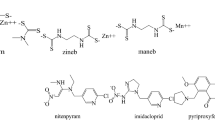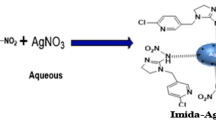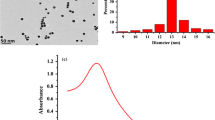Abstract
Paraquat is one of the most toxic materials widely applied in agriculture in most countries. In the present study, a simple, innovative and inexpensive nano biosensor which is based on a thioglycolic acid (TGA) - CdTe@CdS core-shell nanocrystals (NCs) to detect paraquat, is suggested. The NCs based biosensor shows a linear working range of 10–100 nM, and limited detection of 3.5 nM. The proposed sensor that has been well used for the detection and determination of paraquat in natural water samples is collected from corn field and a canal located near to the corn field yielding recoveries as high as 98%. According to our findings, the developed biosensor shows reproducibility and high sensitivity to determine paraquat in natural water samples in which the amount of paraquat has low levels. The suggested method is efficiently applied to paraquat determination in the samples of natural water that are collected from a tap water and a canal located near to the cornfield.









Similar content being viewed by others
Data Availability
Not applicable.
References
Siangproh W, Somboonsuk T, Chailapakul O, Songsrirote K (2017) Novel colorimetric assay for paraquat detection on-silica bead using negatively charged silver nanoparticles. Talanta 174:448–453. https://doi.org/10.1016/j.talanta.2017.06.045
dos Santos LBO, Infante CMC, Masini JC (2010) Development of a sequential injection–square wave voltammetry method for determination of paraquat in water samples employing the hanging mercury drop electrode. Anal Bioanal Chem 396:1897–1903. https://doi.org/10.1007/s00216-009-3429-x
Chuntib P, Themsirimongkon S, Saipanya S, Jakmunee J (2017) Sequential injection differential pulse voltammetric method based on screen printed carbon electrode modified with carbon nanotube/Nafion for sensitive determination of paraquat. Talanta 170:1–8. https://doi.org/10.1016/j.talanta.2017.03.073
Gao R, Choi N, Chang S-I et al (2010) Highly sensitive trace analysis of paraquat using a surface-enhanced Raman scattering microdroplet sensor. Anal Chim Acta 681:87–91. https://doi.org/10.1016/j.aca.2010.09.036
Sun S, Li F, Liu F et al (2015) Fluorescence detecting of paraquat using host-guest chemistry with cucurbit[8]uril. Sci Rep 4:3570. https://doi.org/10.1038/srep03570
de Figueiredo-Filho LCS, Baccarin M, Janegitz BC, Fatibello-Filho O (2017) A disposable and inexpensive bismuth film minisensor for a voltammetric determination of diquat and paraquat pesticides in natural water samples. Sensors Actuators B Chem 240:749–756. https://doi.org/10.1016/j.snb.2016.08.157
Onyon LJ, Volans GN (1987) The epidemiology and prevention of paraquat poisoning. Hum Toxicol 6:19–29. https://doi.org/10.1177/096032718700600104
Tu J, Xiao L, Jiang Y et al (2015) Near-infrared fluorescent turn-on detection of paraquat using an assembly of squaraine and surfactants. Sensors Actuators B Chem 215:382–387. https://doi.org/10.1016/j.snb.2015.04.015
Geng P, Jinzhang C, Lijing Z, Mengzhi X, Zezheng L, Jing Z, Zhiyi W, Xianqin Wang CW, Ma J (2017) Liver tissue metabonomics in rat after acute paraquat poisoning gas chromatography-mass spectrometry. Int J Clin Exp Med 10:937–943
Faust SD, Hunter NE (1965) Chemical methods for the detection of aquatic herbicides. J Am Water Works Assoc 57:1028–1037. https://doi.org/10.1002/j.1551-8833.1965.tb01494.x
Gill R, Qua SC, Moffat AC (1983) High-performance liquid chromatography of paraquat and diquat in urine with rapid sample preparation involving ion-pair extraction on disposable cartridges of octadecyl-silica. J Chromatogr A 255:483–490. https://doi.org/10.1016/S0021-9673(01)88303-5
Tomková H, Sokolová R, Opletal T et al (2018) Electrochemical sensor based on phospholipid modified glassy carbon electrode - determination of paraquat. J Electroanal Chem 821:33–39. https://doi.org/10.1016/j.jelechem.2017.12.048
Jain A, Verma KK, Townshend A (1993) Determination of paraquat by flow-injection spectrophotometry. Anal Chim Acta 284:275–279. https://doi.org/10.1016/0003-2670(93)85311-7
Zhao Z, Zhang F, Zhang Z (2018) A facile fluorescent “turn-off” method for sensing paraquat based on pyranine-paraquat interaction. Spectrochim Acta Part A Mol Biomol Spectrosc 199:96–101. https://doi.org/10.1016/j.saa.2018.03.042
Wigfield YY, McCormack KA, Grant R (1993) Simultaneous determination of residues of paraquat and diquat in potatoes using high-performance capillary electrophoresis with a ultraviolet detection. J Agric Food Chem 41:2315–2318. https://doi.org/10.1021/jf00036a018
Núñez O, Moyano E, Galceran M (2002) Solid-phase extraction and sample stacking–capillary electrophoresis for the determination of quaternary ammonium herbicides in drinking water. J Chromatogr A 946:275–282. https://doi.org/10.1016/S0021-9673(01)01562-X
Ensafi AA, Kazemifard N, Rezaei B (2015) A simple and rapid label-free fluorimetric biosensor for protamine detection based on glutathione-capped CdTe quantum dots aggregation. Biosens Bioelectron 71:243–248. https://doi.org/10.1016/j.bios.2015.04.015
Ding L, Ruan Y, Li T et al (2018) Nitric oxide optical fiber sensor based on exposed core fibers and CdTe/CdS quantum dots. Sensors Actuators B Chem 273:9–17. https://doi.org/10.1016/j.snb.2018.06.012
Dong L-Y, Wang L-Y, Wang X-F et al (2016) Development of fluorescent FRET probe for determination of glucose based on β-cyclodextrin modified ZnS-quantum dots and natural pigment 3-hydroxyflavone. Dye Pigment 128:170–178. https://doi.org/10.1016/j.dyepig.2016.01.032
Ding L, Zhang B, Xu C et al (2016) Fluorescent glucose sensing using CdTe/CdS quantum dots–glucose oxidase complex. Anal Methods 8:2967–2970. https://doi.org/10.1039/C5AY03205A
Algar WR, Krull UJ (2008) Quantum dots as donors in fluorescence resonance energy transfer for the bioanalysis of nucleic acids, proteins, and other biological molecules. Anal Bioanal Chem 391:1609–1618. https://doi.org/10.1007/s00216-007-1703-3
Zhang M, Cao X, Li H et al (2012) Sensitive fluorescent detection of melamine in raw milk based on the inner filter effect of Au nanoparticles on the fluorescence of CdTe quantum dots. Food Chem 135:1894–1900. https://doi.org/10.1016/j.foodchem.2012.06.070
Shen S-L, Zhang X-F, Ge Y-Q et al (2018) A novel ratiometric fluorescent probe for the detection of HOCl based on FRET strategy. Sensors Actuators B Chem 254:736–741. https://doi.org/10.1016/j.snb.2017.07.158
Frigerio C, Ribeiro DSM, Rodrigues SSM et al (2012) Application of quantum dots as analytical tools in automated chemical analysis: A review. Anal Chim Acta 735:9–22. https://doi.org/10.1016/j.aca.2012.04.042
Bagheri Z, Ehtesabi H, Hallaji Z et al (2018) Investigation the cytotoxicity and photo-induced toxicity of carbon dot on yeast cell. Ecotoxicol Environ Saf 161:245–250. https://doi.org/10.1016/j.ecoenv.2018.05.071
Foubert A, Beloglazova NV, Rajkovic A et al (2016) Bioconjugation of quantum dots: Review & impact on future application. TrAC Trends Anal Chem 83:31–48. https://doi.org/10.1016/j.trac.2016.07.008
Elmizadeh H, Soleimani M, Faridbod F, Bardajee GR (2018) Fabrication and optimization of a sensitive tetracycline fluorescent nano-sensor based on oxidized starch polysaccharide biopolymer-capped CdTe/ZnS quantum dots: Box–Behnken design. J Photochem Photobiol A Chem 367:188–199. https://doi.org/10.1016/j.jphotochem.2018.08.021
Karakoti AS, Shukla R, Shanker R, Singh S (2015) Surface functionalization of quantum dots for biological applications. Adv Colloid Interface Sci 215:28–45. https://doi.org/10.1016/j.cis.2014.11.004
Banerjee A, Grazon C, Nadal B et al (2015) Fast, efficient, and stable conjugation of multiple DNA strands on colloidal quantum dots. Bioconjug Chem 26:1582–1589. https://doi.org/10.1021/acs.bioconjchem.5b00221
Banerjee A, Grazon C, Pons T et al (2017) A novel type of quantum dot–transferrin conjugate using DNA hybridization mimics intracellular recycling of endogenous transferrin. Nanoscale 9:15453–15460. https://doi.org/10.1039/C7NR05838A
Wang J, Jiang P, Gao L et al (2013) Unique self-assembly properties of a bridge-shaped protein dimer with quantum dots. J Nanoparticle Res 15:1914. https://doi.org/10.1007/s11051-013-1914-9
Su X, Chan C, Shi J et al (2017) A graphene quantum dot@Fe 3 O 4 @SiO 2 based nanoprobe for drug delivery sensing and dual-modal fluorescence and MRI imaging in cancer cells. Biosens Bioelectron 92:489–495. https://doi.org/10.1016/j.bios.2016.10.076
Jin T, Sun D, Su JY et al (2009) Antimicrobial efficacy of zinc oxide quantum dots against Listeria monocytogenes, Salmonella Enteritidis, and Escherichia coli O157:H7. J Food Sci 74:M46–M52. https://doi.org/10.1111/j.1750-3841.2008.01013.x
Zhou J, Deng W, Wang Y et al (2016) Cationic carbon quantum dots derived from alginate for gene delivery: One-step synthesis and cellular uptake. Acta Biomater 42:209–219. https://doi.org/10.1016/j.actbio.2016.06.021
Samia ACS, Chen X, Burda C (2003) Semiconductor quantum dots for photodynamic therapy. J Am Chem Soc 125:15736–15737. https://doi.org/10.1021/ja0386905
Feizi S, Zare H, Hoseinpour M (2018) Investigation of dosimetric characteristics of a core–shell quantum dots nano composite (CdTe/CdS/PMMA): fabrication of a new gamma sensor. Appl Phys A 124:420. https://doi.org/10.1007/s00339-018-1837-5
Zare H, Ghalkhani M, Akhavan O et al (2017) Highly sensitive selective sensing of nickel ions using repeatable fluorescence quenching-emerging of the CdTe quantum dots. Mater Res Bull 95:532–538. https://doi.org/10.1016/j.materresbull.2017.08.015
Li Y, Sun L, Liu Q et al (2016) Photoelectrochemical CaMV35S biosensor for discriminating transgenic from non-transgenic soybean based on SiO2@CdTe quantum dots core-shell nanoparticles as signal indicators. Talanta 161:211–218. https://doi.org/10.1016/j.talanta.2016.08.047
İnal EK (2020) A fluorescent chemosensor based on schiff base for the determination of Zn2+, Cd2 + and Hg2+. J Fluoresc 30:891–900. https://doi.org/10.1007/s10895-020-02563-6
Nirmal M, Dabbousi BO, Bawendi MG et al (1996) Fluorescence intermittency in single cadmium selenide nanocrystals. Nature 383:802–804. https://doi.org/10.1038/383802a0
Marandi M, Emrani B, Zare H (2017) Synthesis of highly luminescent CdTe/CdS core-shell nanocrystals by optimization of the core and shell growth parameters. Opt Mater (Amst) 69:358–366. https://doi.org/10.1016/j.optmat.2017.04.058
Yu Y, Zhang K, Li Z, Sun S (2012) Synthesis and luminescence characteristics of DHLA-capped PbSe quantum dots with biocompatibility. Opt Mater (Amst) 34:793–798. https://doi.org/10.1016/j.optmat.2011.11.008
Wu T, He K, Zhan Q et al (2015) Partial protection of N-acetylcysteine against MPA-capped CdTe quantum dot-induced neurotoxicity in rat primary cultured hippocampal neurons. Toxicol Res (Camb) 4:1613–1622. https://doi.org/10.1039/C5TX00127G
Chen Y, Chen Z, He Y et al (2010) L-cysteine-capped CdTe QD-based sensor for simple and selective detection of trinitrotoluene. Nanotechnology 21:125502. https://doi.org/10.1088/0957-4484/21/12/125502
Shankara Narayanan S, Sinha SS, Verma PK, Pal SK (2008) Ultrafast energy transfer from 3-mercaptopropionic acid-capped CdSe/ZnS QDs to dye-labelled DNA. Chem Phys Lett 463:160–165. https://doi.org/10.1016/j.cplett.2008.08.057
Jhonsi MA, Renganathan R (2010) Investigations on the photoinduced interaction of water soluble thioglycolic acid (TGA) capped CdTe quantum dots with certain porphyrins. J Colloid Interface Sci 344:596–602. https://doi.org/10.1016/j.jcis.2010.01.022
Khan S, Carneiro LSA, Vianna MS et al (2017) Determination of histamine in tuna fish by photoluminescence sensing using thioglycolic acid modified CdTe quantum dots and cationic solid phase extraction. J Lumin 182:71–78. https://doi.org/10.1016/j.jlumin.2016.09.041
Fernández-Argüelles MT, Costa-Fernández JM, Pereiro R, Sanz-Medel A (2008) Simple bio-conjugation of polymer-coated quantum dots with antibodies for fluorescence-based immunoassays. Analyst 133:444. https://doi.org/10.1039/b802360n
Shiohara A, Hanada S, Prabakar S et al (2010) Chemical reactions on surface molecules attached to silicon quantum dots. J Am Chem Soc 132:248–253. https://doi.org/10.1021/ja906501v
Pourghobadi Z, Mirahmadpour P, Zare H (2018) Fluorescent biosensor for the selective determination of dopamine by TGA-capped CdTe quantum dots in human plasma samples. Opt Mater (Amst) 84:757–762. https://doi.org/10.1016/j.optmat.2018.08.003
Uvarov V, Popov I (2007) Metrological characterization of X-ray diffraction methods for determination of crystallite size in nano-scale materials. Mater Charact 58:883–891. https://doi.org/10.1016/j.matchar.2006.09.002
Lakowicz JR (2013) Principles of fluorescence spectroscopy. Springer Sci Bus Media, Berlin
Matylitsky VV, Dworak L, Breus VV et al (2009) Ultrafast charge separation in multiexcited CdSe quantum dots mediated by adsorbed electron acceptors. J Am Chem Soc 131:2424–2425. https://doi.org/10.1021/ja808084y
Li H, Liu J, Yang X (2015) Facile synthesis of glutathione-capped CdS quantum dots as a fluorescence sensor for rapid detection and quantification of paraquat. Anal Sci 31:1011–1017. https://doi.org/10.2116/analsci.31.1011
Jenkins R, de Vries JL (1997) An introduction to X-ray powder diffractometryNo Title. NV Philips 36:1128
Scherrer PJNGWG (1918) Estimation of the size and internal structure of colloidal particles by means of röntgen. Nachr Ges Wiss Göttingen 2:96–100
Ghalkhani M, Maghsoudi S, Saeedi R, Khaloo SS (2019) Ultrasensitive quantification of paraquat using a newly developed sensor based on silver nanoparticle-decorated carbon nanotubes. J Iran Chem Soc 16:1301–1309. https://doi.org/10.1007/s13738-019-01605-6
Acknowledgements
The authors greatly appreciate the financial support to the present study by the Khorramabad Branch of Islamic Azad University, Lorestan Province, Iran.
Author information
Authors and Affiliations
Contributions
The all authors confirm that the manuscript have been read and approved by all named authors. We further confirm that the order of authors listed in the manuscript has been approved by all of us.
Corresponding author
Ethics declarations
Competing Interests
The authors declare that they have no conflict of interest.
Code Availability
Not applicable.
Additional information
Publisher’s Note
Springer Nature remains neutral with regard to jurisdictional claims in published maps and institutional affiliations.
Rights and permissions
About this article
Cite this article
Pourghobadi, Z., Makanali, H. & Zare, H. Highly Sensitive Fluorescent Probe for Detection of Paraquat Based on Nanocrystals. J Fluoresc 31, 559–567 (2021). https://doi.org/10.1007/s10895-020-02679-9
Received:
Accepted:
Published:
Issue Date:
DOI: https://doi.org/10.1007/s10895-020-02679-9




